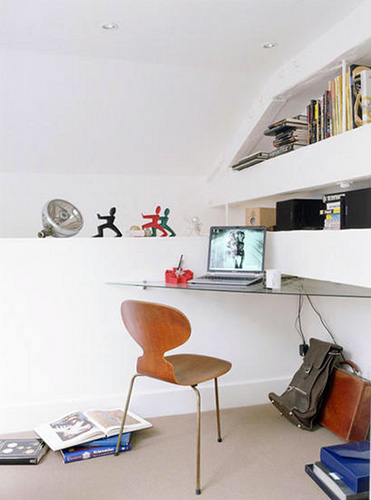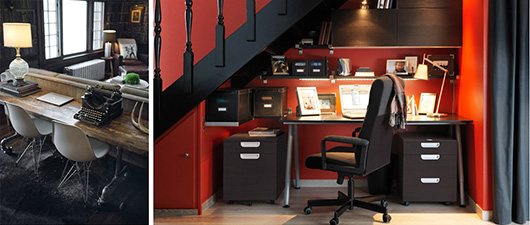Nobody wants to do work when they get home from a long day at… work. But sometimes it’s a necessary evil. And productivity levels rise exponentially when you have a dedicated office space. Extra room for an office can be hard to come by, especially if you live in a tiny studio; but it is possible. Here are seven ways to add a small desk area to your existing apartment.
1. Try a convertible desk.
If you can’t spare floor space, a wall-mounted fold-up desk can be the perfect solution. These desks open up to create a large work surface when you have work to do, and they fold right back up when your friends come over on the weekend. They have virtually no footprint when they’re closed, but will provide you with ample space when you need to finish up that pesky expense report. Some have more storage than others, so be sure to think about whether you need an area to stash office supplies or paperwork. Check out this convertible desk from Amazon.
2. Use an extra closet.
If you have some extra closet space, place a shallow desk inside along with a compact office chair. This is a great solution for those of us who tend to have disorganized workspaces. When you aren’t working, simply close the closet doors or hang a curtain to hide the clutter. In the same vein, add floating shelves to an inset area of your wall as shown in the photo above. Use a deeper shelf for your work surface, and shallower shelves above for storage.
3. Buy a glass desk.
The transparency of any glass object makes it feel smaller than it really is, making it an ideal material for a tiny apartment. Pair a glass desk with a small, neutral-colored office chair for a workspace that blends in with the rest of the room. Here’s a large selection of affordable glass desks at Wal-Mart.
4. Try a C table.
C tables are convenient because they can be moved from place to place, allowing you to work wherever you feel comfortable. The design allows for great flexibility; a C table will fit over your lap if you like to work on the couch, or it can even fit over most beds if you like to work late at night. It is ideal for people who have a more transient working style, enabling you to easily shift to different spots in your home. If you’re handy, try using this easy tutorial to make one yourself. If using a screwdriver makes you cringe, try buying one of these.
5. Don’t forget about the corner.
The corner of a room is another underutilized area that has great potential for a workspace. Some corner desks can be as unassuming as a triangular glass shelf, while others are more substantial with storage cabinets and shelves. If you live in a tiny studio, then a glass corner desk might be ideal for you. But if you have a bit more square footage to play with, consider a larger desk with space to conceal any clutter that may accumulate. Here are a number of great corner desk options.
6. Utilize unexpected places.
This idea will require you to think outside of the box. Sometimes, the perfect spot for a desk is hiding right in plain sight. Consider moving your sofa away from the wall and placing a shallow desk behind it. And when you’re not using the desk for work, it can double as an extra surface for your beer while you’re watching Monday Night Football. The area beneath the stairs is another underutilized space that could be converted into a small office. If you have a staircase in your place, think about finding a desk that will fit underneath. Using an existing empty space will allow you to use your space even more efficiently.
7. When in doubt, buy a laptop stand.
Laptop stands have the convenience of a C table but with added functionality that allows the height and angle to be adjusted. They may not look quite as appealing as the aforementioned options, but the added utility could make this the most practical option for some people. They are also small enough to be tucked in the closet when necessary.
Space is a commodity these days, so finding a spot for a home office can be challenging; but with a bit of ingenuity and a creative eye, a place to work can be forged from almost any area. The key is to choose the right work surface for your space, and to place it strategically within the room. And who knows, maybe you’ll even get your work done faster once you have your own home office!























